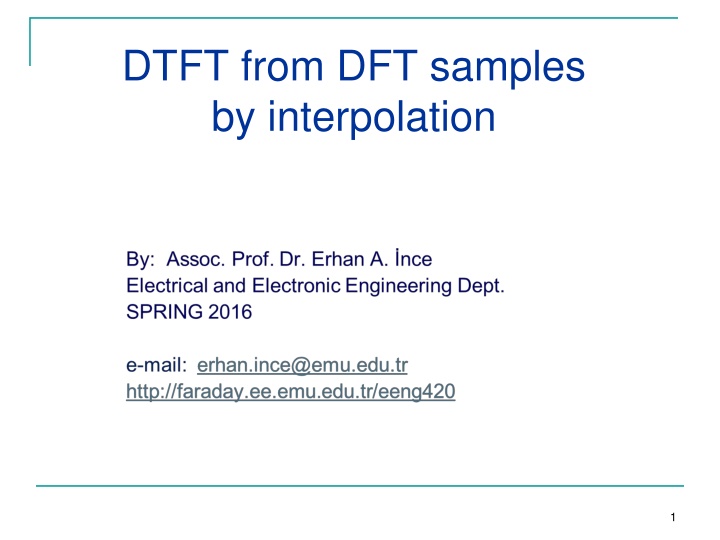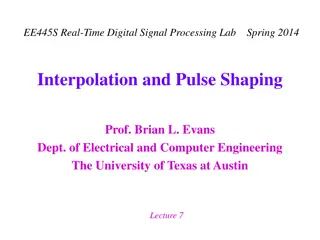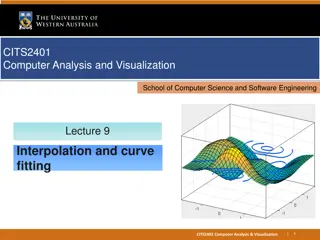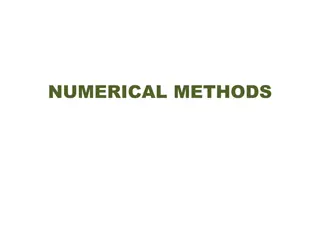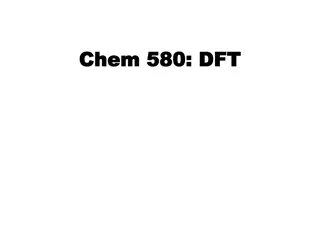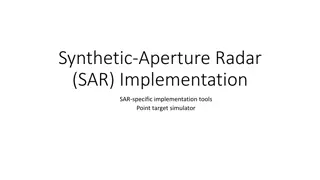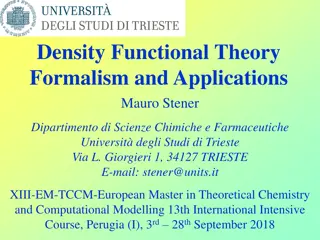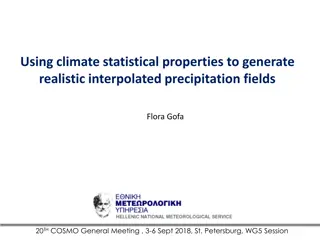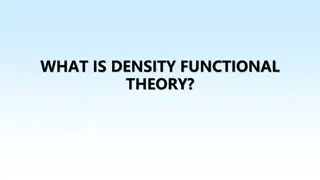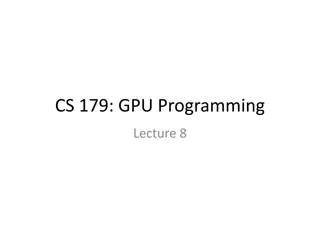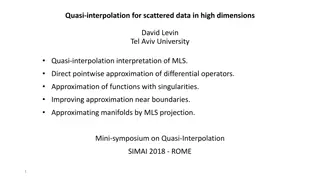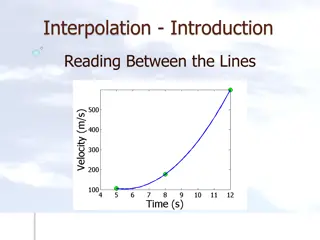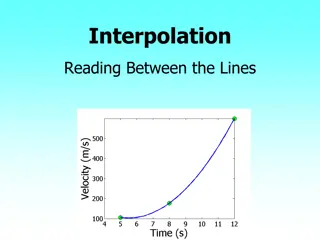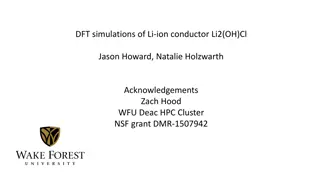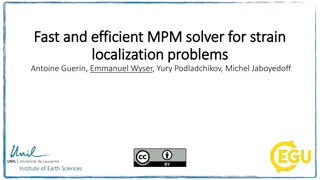DFT and DTFT Interpolation
Delve into the relationship between Discrete Fourier Transform (DFT) and Discrete-Time Fourier Transform (DTFT) through interpolation. Explore how to derive DTFT from DFT samples, the synthesis and analysis formulas, the importance of sequence length in relation to N-point DFT, sampling strategies, and more.
Download Presentation

Please find below an Image/Link to download the presentation.
The content on the website is provided AS IS for your information and personal use only. It may not be sold, licensed, or shared on other websites without obtaining consent from the author.If you encounter any issues during the download, it is possible that the publisher has removed the file from their server.
You are allowed to download the files provided on this website for personal or commercial use, subject to the condition that they are used lawfully. All files are the property of their respective owners.
The content on the website is provided AS IS for your information and personal use only. It may not be sold, licensed, or shared on other websites without obtaining consent from the author.
E N D
Presentation Transcript
DTFT from DFT samples by interpolation 1
N-point DFT (X[k]) of a given length-N sequence, x[n], is the frequency values of its DTFT,? ???,evaluated at ? uniformly spaced frequency points. ? = ??=2?? 0 ? (? 1) ? Given the N-point DFT, ie. X[k], its DTFT can be uniquely determined from X[k] ? 1 ? ???= ?[?]? ??? ?=0 ? 1 ? 1 1 ? ?=0 ?? ? ??? = ?[?]?? ?=0 ? 1 ? 1 =1 ? ? ? 2?? ? ? ? ?=0 ?[?] ?=0 S 2
?1 1 ? ? ?? 2?? =1 ? ?=0 ?[?] 2??? 1 ? ? ? sin?? 2?? ? 1 =1 ? ? ? 2?? ? 1 2 2 ? ?=0 ? ? ? sin?? 2?? 2? Interpolation function for getting ? ??? from X[k] 3
DTFT Sampling The DTFT is ? ???= ? ? = ?= ?[?]? ??? ? 1? ? ? ?2? ??? The DFT analysis formula is: ? ? = ?=0 If x[n] is a L-point signal, i.e. it is non-zero only in the 0 ? ? 1 range the DTFT can be written as: ? 1 ?[?]? ??? ? ? = ?=0 If we compare these two formulas we see that: for the N-point DFT values to be samples of the DTFT the length L of the sequence x[n] must be less than N (i.e. L <= N) X k = X w |?=2?? 4 ?
If we are given X(w) and we wish to find x[n] we can use the synthesis formula: ? 1 ?(?)?????? ? ? = 2? ? However performing the integral may be inconvenient. The following is an easier approach: 1) Sample DTFT X(w) to get DFT values X[k] for k= 0, , (N-1) 2) Take inverse DFT of X[k] to get back x[n] Does this always work ? No. For this to work L <=N. 5
Example: x[n] 1 n 0 2 DTFT 3 1 ? ???=1 ? ?4? ??? 2? ??? ?/2 1 ? ??= ? ?3? ? ???= 2 ?=0 DTF 3 1 ? ?2? 4??= 1 + ? ?? 2?+ ? ???+ ? ?3? 2? ? ? = ?=0 = 4 k=0 0 k = 1,2,3 6
Sampling DTFT ? ? = ? ??2? = ? ?3?? ? = 0 ? = 1,2,3 ??? ?? ??? ??/4= 4 4? 0 4 7
Sampling in frequency: Sample ? ??? at ??=2?? ? 0 ? (? 1) ? ??? ??? = ? ???2? ? ? ??? ? ??? ? - ? ??? ??? = ? ? ? ? = x[n] ? ? ?? 0 2? 4? ? ?= ? = ? ? ?? ?= 8
??? = ? ? ? Original signal x[n] is replicated in time at integer multiples of M x[n] n xs[n] n -M 0 M 9
Sampling in frequency => replication in time Sampling in time => replication in frequency ???? ? ??? and ??? = ? ??? If ? ? ? = 0, , ? 1 ?=2?? ? ???? ??? where ??? = ?= then ??? ? ? ?? To recover x[n] from ??? ,x[n] must be time limited to <= M values Otherwise we have aliasing. 10
Since xp[n] is the periodic extension of x[n] it is clear that x[n] can be recovered from xp[n] if there is no aliasing in the time domain. That is if x[n] is time-limited to less than the period N of xp[n].This is depicted below: x[n] n 0 L xp[n] N>=L No aliasing n 0 L N xp[n] N<L aliasing n 0 N 11
Example : ? ? = ??? ? where ? < 1 1 X w = 1 ?? ?? Here the time domain signal is npot time-limited (i.e. L = ) Now suppose we take N samples of this DTFT i.e ? ?? = ? ? ?=2? 2? ?? 12
for a = 0.7 ? ? = ??? ? 1 0.9 0.8 0.7 0.6 0.5 0.4 0.3 0.2 0.1 -5 0 0 5 10 15 20 25 30 1.4 1.2 1 0.8 0.6 N=6 samples 0.4 0.2 -10 0 -5 0 5 10 15 20 x[n] san not be recovered from replicated time-domain signal since L > N Note for n >20 x[n] starts to vanish so if N=20 or more is chosen then x[n] can be recovered from the time-domain signal 13
